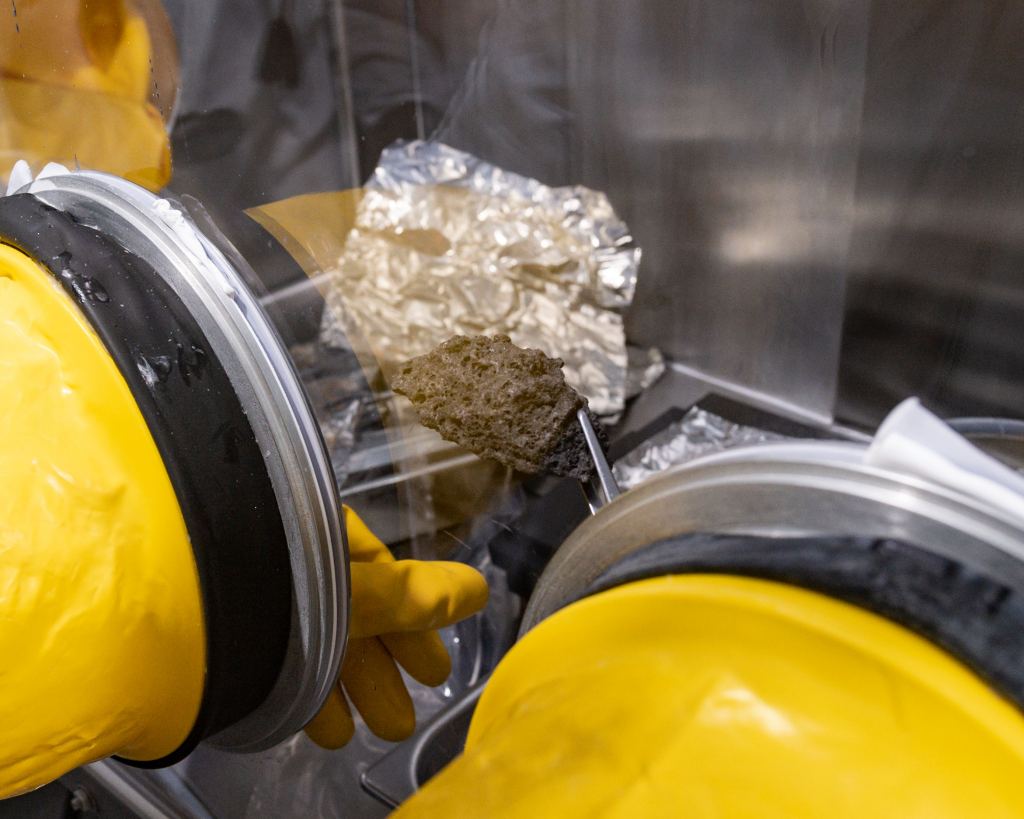 Curators handling lunar rocks take extreme care to keep these materials from contamination as they work with them in cold boxes using gloves and protective gear. This frozen Apollo 17 sample is being studied in a nitrogen-purged glove box at NASA Johnson Space Flight Center. Courtesy NASA/Robert Markowitz.
Curators handling lunar rocks take extreme care to keep these materials from contamination as they work with them in cold boxes using gloves and protective gear. This frozen Apollo 17 sample is being studied in a nitrogen-purged glove box at NASA Johnson Space Flight Center. Courtesy NASA/Robert Markowitz.
Ever wonder what happened to all those collections of rocks and dust the Apollo astronauts brought back from the Moon? Some of those lunar samples were studied right away. Others made their way into a few museums and science centers and the desks of world leaders. Still others landed in storage at NASA Johnson’s Space Center in Houston. Some got stored at room temperature while others were put into a deep freeze. The idea was to preserve any traces of gases or water or possibly organic materials on them. Now, some of these lunar samples are at the NASA Goddard Space Flight Center in Maryland, where they’re under examination for the first time in 50 years using new techniques not available during the Apollo years.
What Do Lunar Samples Have to Tell Us?
Why study old lunar rocks and dust? And, how do you do it? For Natalie Curran, principal investigator for the Mid Atlantic Noble Gas Research Lab at Goddard, the history the samples have experienced on the Moon is a big draw. The lunar surface is a harsh place. There’s no atmosphere and no flowing water. Impact craters, radiation from the Sun, and cosmic rays are the biggest agents of surface change on the Moon.
“Our work allows us to use noble gases, such as argon, helium, neon, and xenon, to measure the duration a sample has been exposed to cosmic rays, and this can help us understand the history of that sample,” said Curran. “Cosmic rays can be damaging to organic material that may be in a sample, so understanding the duration helps to determine the effects that exposure has had on the organic.”
Colleague Jamie Elsila, a research scientist in Goddard’s Astrobiology Analytical Laboratory, finds the existence of small, volatile organic compounds in the samples fascinating. That’s includes amino acids, which are essential to life on Earth. And, they aren’t just found on the Moon and asteroids. They likely exist in a variety of very different places across the solar system, which is what she and her team want to understand.
“We think some of the amino acids in the lunar soils may have formed from precursor molecules, which are smaller, more volatile compounds such as formaldehyde or hydrogen cyanide,” she said. “Our research goal is to identify and quantify these small organic volatile compounds, as well as any amino acids, and to use the data to understand the prebiotic organic chemistry of the Moon.”
Taking Care of Precious Lunar Samples
Several years ago, the Artemis Curation Team at Johnson, led by NASA scientist Julie Mitchell, began planning a new facility. They wanted a place where the Apollo 17 materials could be processed for further study. Creating the lab also provided a chance to plan for the delivery and stated-of-the-art handling of rocks and dust from upcoming Moon missions. Artemis is the next one to go up from NASA. Although the mission is delayed, its eventual launch (possibly in 2025) will deliver the first woman to the Moon. It will also start up the collection of lunar samples where Apollo left off.
The first step was to design and retrofit a special lab for sample preparation. “By doing this work we’re not just facilitating Artemis exploration. We’re facilitating future sample return and human exploration into the rest of the solar system,” Mitchell said. “I feel very privileged to contribute in this small way by developing the capabilities for us to collect these materials, bring them home safely, and curate them for the long term.”
It’s tough to pack the Apollo samples for shipment and keep them pristine. According to Ryan Zeigler, Apollo sample curator, doing it in the cold made things even more difficult. But, it was worth it, he said. Ziegler works at the Astromaterials Research and Exploration Science (ARES) division at Johnson. “It’s an important learning lesson for Artemis, as being able to process samples in the cold will be even more important for the Artemis mission than it is for Apollo. This work gives us some lessons learned and a good feed forward for Artemis.”
Keeping things Chill
Cold sample storage is important. It keeps materials from other worlds safe and free from contamination by Earth dirt, rocks, and life. Why is this crucial? For one thing, scientists want to study ONLY Moon materials, not Earth buggies. That’s important when they want to know what conditions are like on the lunar surface.
In addition, future lunar missions will focus on gathering materials from the Moon’s polar regions. That means ice crystals could get brought back, mingled with the dust and rocks. On other parts of the Moon, impact sites could contain amino acids or other organic compounds. Those come from the bits of asteroids that have slammed into the lunar surface. Obviously, it’s important to keep the ice in its pristine, frozen state and the amino acids and other materials safe from Earth-bound contamination. That’s why some of the Apollo samples were “on ice” all these years.
Both frozen and non-frozen Apollo 17 samples arrived at Goddard safely. Now, lunar scientists are focused on teasing out their secrets. Ongoing work on these samples, and future returns from other places, will give new insights about the origin and evolution of other worlds in the solar system.
For more information:
NASA Goddard Scientists Begin Studying 50-year-old Frozen Apollo 17 Samples

